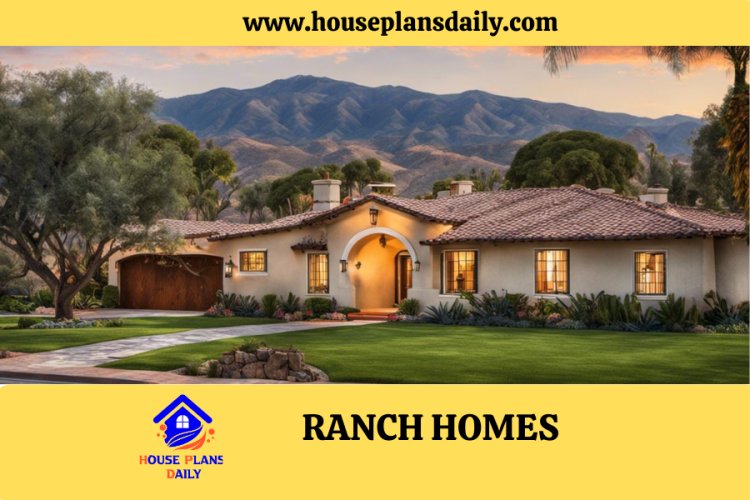Ranch Home | House Plans Daily | Ranch Houses
As a testament to mid-20th-century Americana, ranch homes embody an architectural style that extends far beyond its origins, reflecting a tapestry of cultural, historical, and design influences.
Ranch Home
As a testament to mid-20th-century Americana, ranch homes embody an architectural style that extends far beyond its origins, reflecting a tapestry of cultural, historical, and design influences. Affordability, practicality, and connection to the land gave birth to a unique style now deeply ingrained in the American architectural landscape. This exploration delves into the compelling journey of ranch homes, from the post-war boom that prompted their rise, to the Spanish Colonial elements that inspired their aesthetics, and the evolution into the open, casual floor designs that define them today. Moreover, the analysis encapsulates the key characteristics of ranch home design, visually dissecting the hallmark features that make these homes both inviting and functional.
History of Ranch Homes
Oh, those sprawling, charming ranch homes! There’s an undeniable allure to these single-story architectural icons that render them appealing to hobbyists and enthusiasts, even today. The unique architectural style of ranch homes is classic, humble and practical, a beauty altogether borne out of sheer simplicity. Here we’ll dive into the captivating journey of their inception, their wondrous adaptation, and evolution that persists in shaping the American landscape.
Riding on a time machine back to the 1920s, one lands on the scenic Californian landscape, the original birthplace of the ranch style, inspired truly by the Mexican ranchos and Spanish Missions. Blending practicality and elegance seamlessly, the first ranch homes were designed by architects who sought to harvest the best of vernacular and modernist style such as Cliff May and William Wurster. Their fascination for creating spaces that would form a fluid connection with the outdoors led to designs with a wide spread layout and numerous windows, allowing natural light to beautifully bathe every corner of the house.
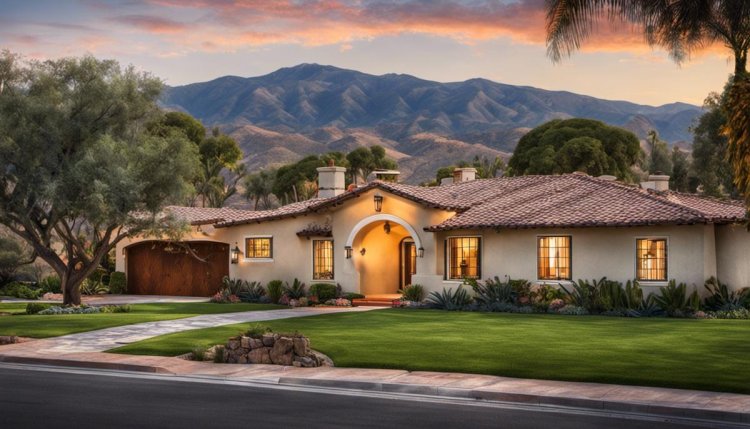
Ranch house design
Moving into the 1940s, post-World War II, a rapid explosion was witnessed in ranch style home construction. With mass production techniques being readily available and families growing, affordable, commodious homes became the need of the hour. Ranch homes met these criteria perfectly and became an embodiment of the American Dream - a symbol of prosperity and family values. New material innovations were also integrated, like aluminum windows and asphalt shingles replacing traditional wood and tiles.
As the population moved outwards into the suburbs in the 1950s and 60s, ranch homes followed suit. Their aesthetic evolved to include more familiar, cozy aspects like attached garages and open concept living areas for a sense of spaciousness. The exterior facades started displaying a variety of styles, from brick and stucco to wood sidings, retaining the humility of the original design ethos while increasing customization possibilities, convenience, and comfort.
However, toward the close of the 70s, the popularity of ranch homes dwindled. The soaring prices of land and a preference for multi-story homes with a smaller footprint hit the sales of these homes hard. Consequently, they were viewed as outmoded and representative of old dated designs.
Fast forward to the present day; ranch homes are revitalizing themselves and garning a newfound respect. With modernist styles again in vogue, the simplicity and openness of ranch homes have caught the attention of homeowners seeking efficient, eco-friendly living options. Their one-floor layout is perfect for aging-in-place and the interest in mid-century furniture and art have added an exotic allure, prompting a revival.
From being plain homes built for practicality to architectural icons that echo the American Dream, ranch style homes have truly come a long way. Their evolution is a testimony to our own changing societal values and lifestyle preferences, proving once again how architecture is a reflection of life itself.
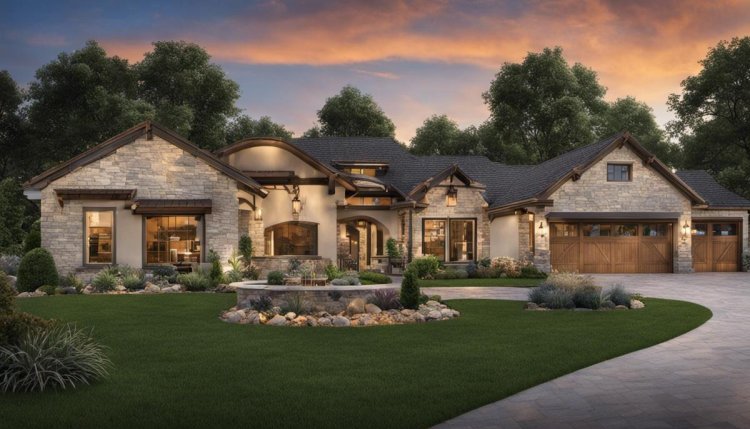
Ranch Home Design
Elements of Ranch Home Design
Delving deep into the architectural mystique of ranch homes, a few key design elements truly capture the essence of this extraordinary design. It's these elements that set them apart from other architectural styles and etch a unique stamp on America's map of home styles.
One pivotal element of ranch style homes that truly fronts their design is the layout's simplicity. This simplicity should not be mistaken for blandness. In fact, it's quite the opposite. The simple lines coupled with a low-pitched roof encapsulate both beauty and practicality in a single sweep. The low-to-the ground profile this creates is unmistakably distinctive, especially when viewed from the outdoor horizon.
Equally significant is the emphasis on the horizontal orientation, seemingly mimicking the sprawling landscapes of the western ranchos they were inspired from. The majority of ranch homes exhibit this orientation, with lengthy, linear arrangements that hug the terrain they rest on. This horizontal emphasis not only predicates the exterior visual impact, but also dictates the interior architecture, with a layout focused on easy movement from room to room, typically without the need to climb stairs.
A quintessential feature of every ranch home is its integration with nature. Notably, this is achieved through generous provision of windows and sliding glass doors, merging indoor and outdoor spaces seamlessly. Ranch homes may often feature patios, designed to be organic extensions of the main living areas, further emphasizing this harmony with the surrounding outdoors.
One cannot bypass the role of materials in defining the uniqueness of ranch homes. Traditional building materials, such as stucco, brick, or wood often dress the exteriors, creating character and a timeless appeal. Contemporary iterations also widely adopt sustainable materials and eco-friendly technologies, marrying tradition with modern environmental consciousness.
Functionality and purpose conclude the key elements characterizing ranch homes. Born of a time when homeownership was booming, these homes catered to the influx of families seeking comfortable and affordable homes. Expansive basements, for instance, highlighted these homes' duality in providing both space and utility, offering room for recreation, storage, or additional living quarter.
In the context of style, it's interesting to note that while ranch homes were born from practical concerns, they have managed to incorporate various chic elements over the years. One might find traces of Mid-Century Modern, Spanish Colonial, or Craftsman detailing mingled within their architecture - the ranch home is nothing if not a captivating amalgamation!
Circling back, the uniqueness of ranch homes truly lies in their design elements; each contributing to a narrative that is undeniably charismatic, humble, but undeniably significant in the timeline of American home architecture. It's no wonder that these resilient single-story wonders continue to find resonance, decade after decade. With the currents of change, the ranch home might embody novel elements in future, but they are sure to stand strong, grounded in their quintessential design roots.
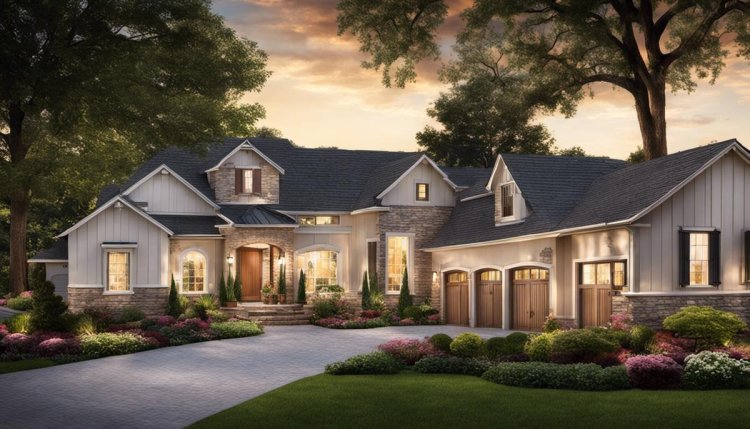
Ranch Homes
Modern Interpretation of Ranch Homes
From the humble ranch style home's inception almost a century ago, the reinterpretation of this architectural masterpiece through modern design principles is nothing short of fascinating.
It's like watching a seasoned artist take a classic masterpiece and transform it into an entirely new, yet recognizable, work of art, promising a refreshing wave of innovation without losing sight of the original creation's beloved elements.
Stepping into the modern reinterpretation zone, it's noticeable right off the bat how architects and designers are retaining the signature single-story design, echoing the essence of the ranch home.
Yet, this simplicity now dances with complex, ingenious floor plans that balance residential aesthetics with functionality.
Complementing the prevailing emphasis on minimalist design trends, open, airy spaces are filled with natural light, thanks to innovative window designs and positions.
The horizontal orientation, another iconic ranch feature, gets refined within these contemporary renditions. Architects employ cutting-edge techniques to achieve a seamless blending of indoor and outdoor spaces, bending the rigid framework of classic ranch homes, while maintaining the single-story look.
Modern landscaping elements get incorporated thoughtfully, encouraging a harmonious relationship with nature without necessitating large lots.
Take a core ingredient of the classic ranch design: the inclusion of traditional building materials. Today, modern architects replace these elements with eco-friendly, locally-sourced materials.
Not only does this enhance the sustainability factor but it also increases energy efficiency — a prime concern in modern architecture.
Look at the way functionality takes center stage in these modern ranch makeovers. Basements, earlier optional, are now considered integral components of the home's structure.
Savvy space utilization strategies ensure these spaces offer additional living areas or serve other customizable functions. Furthermore, smart home technology gets integrated seamlessly, making these renovated ranch homes fully-equipped for the 21st-century lifestyle.
In a surprising turn of events, these modern interpretations of ranch homes refuse to be confined to one architectural style.
Architects pull in elements from various architectural traditions, creating homes that are as eclectic as they are comfortable. This means introducing the clean lines of modernism, the warmth of craftsman-style detailing, or the rustic allure of farmhouse aesthetics into the classic ranch design.
While modern designers are breathing new life into the ranch homes, it's remarkable how they manage to preserve the timeless appeal of the classic design.
The reinvented ranch houses standing in our neighborhoods are a tribute the architects' skill in updating an architectural style without losing its iconic charm. They stand as living proof that the ranch home, despite seeming to be a product of a specific era, transcends time and continues to hold significance in American home architecture.
In essence, the ranch home's reinterpretation in our contemporary times is a beautiful blend of honoring tradition and embracing change.
It illuminates how modern architectural design can blur boundaries, merge styles, and adapt classic designs to meet the demands and tastes of present-day homeowners. And the proof is evident in every charming, singular, and innovatively reimagined ranch home dotting the American suburban landscape.
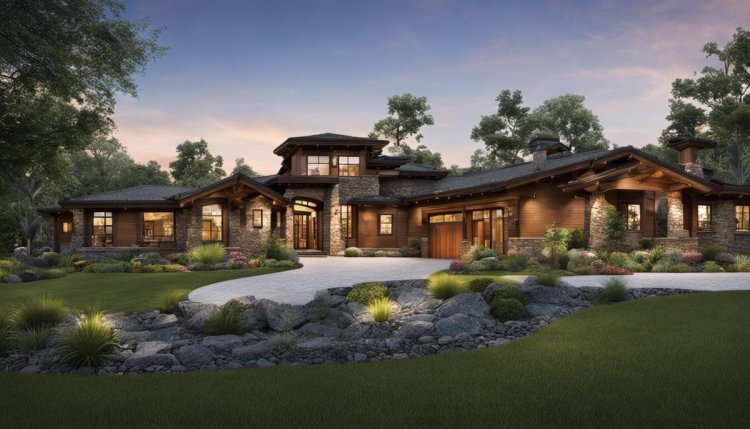
Ranch style house
While basking in the charm of their historical significance, ranch homes continue to demonstrate an uncanny ability to evolve, effortlessly merging modern nuances with traditional ethos. Architecture and design have breathed contemporary life into these homes, fostering unique reimaginations that strike a delightful balance between the past and the present. By synthesizing classic features with progressive design approaches and advanced technologies, these reinterpretations of ranch homes provide a fascinating testament of how a deeply-rooted architectural genre can flex and adapt to the demands of modern living. The continual evolution of ranch homes indeed represents an enduring narrative of the American home, one that continues to enamor, inspire, and stand the test of time.

